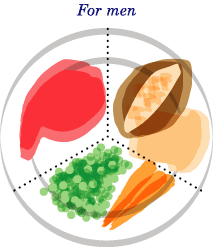An Eye For Portions
Obviously being able to pull out a measuring cup or scale is one way of ensuring that you are on target with your portions or servings, but how realistic is it when you are out to eat at a restaurant or at a friend’s house. Here are some guidelines when it comes to estimating portions. When you are at a buffet or someone else has served you – recall these tips to get you through:
Imagine a standard scoop of mashed potatoes at a cafeteria or standard scoop of ice cream as one half-cup portion. Ask yourself the question, how many scoops are in the portion of rice, pasta or potato on this plate?
Your fist can be used as a standard for one cup serving.
Three ounces of meat is about the size of a full deck of cards or audiocassette tape. For most women, the size of the palm of your hand is approximately equal to 3 to 4 ounces of meat. For most men, the palm is bigger than their female counterpart and would be equal to 4-6 ounces.
1 ounce of nuts is about the amount that can fits comfortably in the palm of your hand or use a shot glass if one is handy.
One teaspoon of butter or peanut butter is about the size of the tip of your thumb to the first joint.
For the olive oil enthusiasts, 1 tablespoon fills the center circle on a coffee cup saucer.


